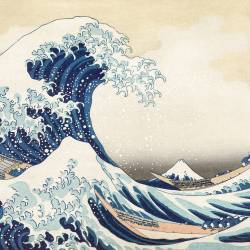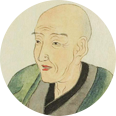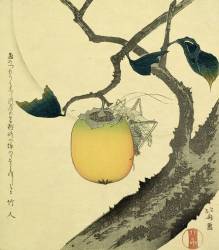Artwork of Hokusai artprints & posters
The best-known Japanese painter of the Edo period, Hokusai left his mark on art history with his Japanese prints, which inspired the greatest artists both in Japan and in Europe, where Japanese inspiration was one of the many influences leading to the golden age of post-impressionist painting. Hokusai's ancient prints are still part of modern art today, as the Japanese artist's line and colors have stood the test of time.
Discover the finest paintings by the best-known printmaker of the late 18th and early 19th centuries, with "The Great Wave", his most famous print from his depictions of Mount Fuji, "The Katakura Tea Plantation in Suruga Province", one of the many landscapes representative of Japanese culture painted by Hokusai, and "The Kengoro Warrior", a brightly colored illustration inspired by the samurai warriors of the Edo period.
Treat yourself to one of the reproductions available in the Hokusai, the master of Japanese prints catalog, and discover his biography.
Biography of Hokusai
Hokusai: a complete training in Japanese printmaking
Born in 1760 in Edo, now Tokyo, probably into a family of artists, Katsushika Hokusai showed an early aptitude for drawing and painting. From the age of 13, he was an apprentice in a xylography workshop, where he learned to make woodcuts, an essential step in the production of Japanese prints. The ukiyo-e movement (which translates as "floating world"), to which printmaking belongs, was very popular in Japanese culture at the time. The engraver was thus a major component of Japanese art, and aspiring artists had to go through engraving training before they could hope to create their own compositions.
At the age of 18, Hokusai was no longer content to make woodcut supports, and entered the school of master Katsukawa Shunshō, a renowned Japanese print painter, as a draftsman. For 14 years, he trained in color and drawing, and produced numerous prints, including portraits of kabuki theater actors, illustration prints for popular books and commercial prints.
In 1792, he decided to leave the Katsukawa workshop, and studied the styles of several schools, before settling more permanently in the Tawaraya school, a major workshop of Japanese painting.
Hokusai's artistic development and recognition
Drawing on his knowledge of many different schools, which, in his own words, he had "penetrated their secrets and gathered the best from them", Hokusai began to develop a certain finesse in his pictorial style, creating illustrations inspired by the best Japanese schools, as well as artistic techniques from China, with the use of Chinese ink for example, or even Western art with the use of perspective, and particular hues and pigments such as Prussian blue.
The Nipponese artist began to make a name for himself among his contemporaries, illustrating the "Kyôka Edo no Murasaki", a collection of short poems (kyoka) that was very popular in 1795. On the strength of this reputation, he became head of the Tawaraya school. He was thus able to practice his art, producing numerous luxurious Japanese prints that were highly appreciated in this Far Eastern country, while passing on his knowledge to his pupils, which was to become an essential mission in his career.
Tired of characters painted on a white background, as was customary in Japan, he began to integrate them into a Japanese landscape drawn in the background. Filled with enthusiasm for this new style of Japanese printmaking, he embarked on a journey between Kyoto and Edo, between 1811 and 1819, to paint the provinces of the Land of the Rising Sun from every angle under the name "Taito", and to transcribe Japanese culture and the art of travel through drawings of Japanese landscapes. The result was a collection of sketches known as "Manga", a veritable drawing manual on Japanese culture and landscapes.
It was also during this period that Hokusai drew his most famous erotic prints. This fringe of Asian art, depicting crude images and erotic, even pornographic, representations of beautiful women and geishas, was very much in vogue and accepted in Edo period Japan, particularly in bourgeois circles. "The Dream of the Fisherman's Wife", produced in 1814, is undoubtedly one of the most representative Japanese prints in this style.
Hokusai's late career: works of maturity
Having developed a great technique over the years, as well as expertise in Japanese painting, particularly in landscape reproductions, it was at the age of sixty that Hokusai entered a very proactive phase of his career, and that the painter's works were at their most masterful. It was in 1830, at the age of seventy, that Hokusai embarked on a project of forty-six prints, which would become known as "Thirty-six Views of Mount Fuji". This series of prints became one of the most emblematic collections of paintings in Asian art. Among these multiple representations of Mount Fuji, signed under the name "Gakyo Rojin Manji", is "The Great Wave of Kanagawa", a work that has enjoyed great success to this day, and reproductions of which are exhibited all over the world, from the Metropolitan Museum of Art in New York and the British Museum in London, to the Brussels Museum of Art and History, the Bibliothèque nationale de France and the Musée Guimet in Paris.
At the age of eighty, despite competition from younger artists such as Utagawa Horishige, Hokusai continued to paint in his studio, abandoning woodblock prints for a more classical style. He died eight years later, leaving behind a plethora of works (over 30,000), making him one of the most productive Japanese painters and printmaking masters of his time.
Hokusai: A multi-faceted artist
Whether during his training or throughout his artistic career, Hokusai signed his works with different names (around 120), which he liked to change according to the periods of his life. Often illustrating membership of an artistic movement or school, or a characteristic of his personality or an important stage in his life, the different artists' names used by Hokusai enable us to retrace his career. Well-known names include "Katsukawa Shunrô" and "Sori II", chosen in his early days, "Gakyōjin Hokusai" ("drawing madman"), "Hokusai Taito aratame Katsushika Iitsu (hitsu)" and "Zen Hokusai Iitsu rōjin", used during his travels and at the start of his career as a recognized artist, or "Iitsu" and "Gakyo Rojin Manji" ("old man mad about painting"), nicknames adopted at the end of his career.
Hokusai's influence on Western painting
Although he lived in a period when art was spreading more and more easily throughout the world, Japan's Edo period and its isolationist policy meant that Hokusai's Japanese paintings didn't reach Europe until the end of the 19th century, during the Meiji era. These works were a gateway to Japanese culture in France, before conquering Europe. The Japanese influence was to find its way into Western literature and European painting, and Western artists of the Impressionist and Post-Impressionist movements, such as the Dutch painter Vincent Van Gogh, or other great Impressionist painters like Degas, Gauguin and Cézanne, would use the codes of the print in their canvases, to create a new and totally innovative style in Western art. This great Japanese wave in the West, at the end of the 19th century, would come to be known as the Japonisme movement, and would lead to Neo-Impressionism and Art Nouveau in the early 20th century.

















































































































































